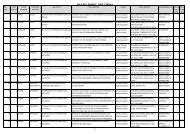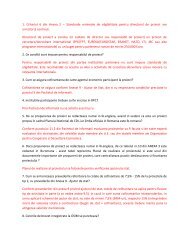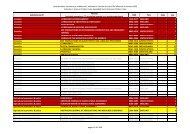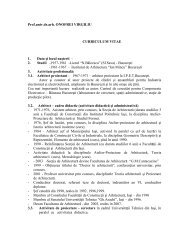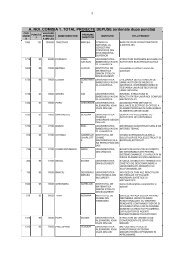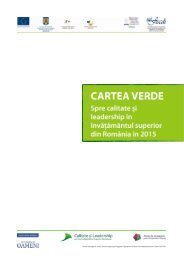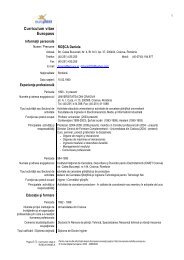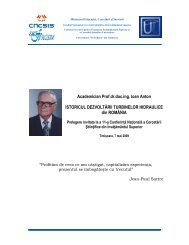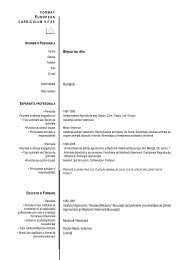Modul de formare-Managementul resurselor financiare - uefiscdi
Modul de formare-Managementul resurselor financiare - uefiscdi
Modul de formare-Managementul resurselor financiare - uefiscdi
- No tags were found...
You also want an ePaper? Increase the reach of your titles
YUMPU automatically turns print PDFs into web optimized ePapers that Google loves.
example, for the estimation of cost related to libraries or laboratories - can be used the stu<strong>de</strong>nts<br />
number as a factor of costs, such as the increasing stu<strong>de</strong>nt number to cause the need of<br />
additional financial resources to cover the costs of library or computer labs. The resulting<br />
allocation is, however, a draft due to the fact that these costs are far more complex.<br />
An alternative, but similar approach is to split the cost of higher education institution in three<br />
categories:<br />
aca<strong>de</strong>mic services;<br />
real estate/ the places specifically inten<strong>de</strong>d to serve the education activities;<br />
central administration<br />
The costs associated to the aca<strong>de</strong>mic services may be covered by allocating resources based on<br />
the formula that reflects both the staff and stu<strong>de</strong>nts number or other priorities such as losses<br />
cover. The education costs with estates service for educational activities have cost parameters<br />
such as space occupied, age of buildings, security requirements etc.. The central administration<br />
costs have as <strong>de</strong>termining factors the staff and stu<strong>de</strong>nt numbers to <strong>de</strong>termine a percentage rate at<br />
which central costs are charged for each faculty.<br />
The top-slicing mo<strong>de</strong>l is used by many universities in the UK with slight differences in its<br />
approach 27 . Thus, Imperial College, University of London is a top-ranking university oriented<br />
toward research. In the aca<strong>de</strong>mic year 2006-2007 the university received total gross income of<br />
over 187 million pounds, but <strong>de</strong>spite the high level of funding, the university still uses the topslicing<br />
mo<strong>de</strong>l to cover the its central overhead costs, which are <strong>de</strong>scribed as infrastructure costs<br />
(infrastructure charge). As a result, the net income allocated down to the aca<strong>de</strong>mic <strong>de</strong>partments<br />
summed 93 million pounds, implying a top slicing rate of almost 50%. In case of University of<br />
Cambridge, ranked first in the UK for research, the financial resource allocation mo<strong>de</strong>l is<br />
similar to the one of Imperial College, University of London, but the central overhead costs are<br />
known as residual funds for strategic use. Their share is 50% of the total revenues and a part of<br />
the funds are discretionary used to cover the aca<strong>de</strong>mic schools <strong>de</strong>ficits.<br />
The Activity Based Costing mo<strong>de</strong>l - ABC highlights the cause and effect relationship between<br />
the services being provi<strong>de</strong>d and the related costs. The mo<strong>de</strong>l has been criticized for the lack of<br />
evi<strong>de</strong>nce of tangible benefits in the private sector, therefore in 1998, 75% of the UK higher<br />
education institutions have rejected its use or its introduction.<br />
Taking into account the relative merits of the different methods of allocating costs we have to<br />
mention that these reflect the different budget control approaches. Regarding the overhead costs<br />
allocation on aca<strong>de</strong>mic units, the <strong>de</strong>cision of budgetary control is at the centre, at the<br />
administrative <strong>de</strong>partment of the university. The institutional transparency is limited, because<br />
the basis for the top slice calculation can be withheld by senior management. There are opinions<br />
that support the mo<strong>de</strong>ls that provi<strong>de</strong> the faculty with the ability to manage the direct costs while<br />
at the centre is kept the responsibility for the budget control of the central or joint <strong>de</strong>partment.<br />
According to other views, it is recommen<strong>de</strong>d the approach and the use of the cumulative<br />
budgets in which the information regarding the costs should be available at the courses level,<br />
study programs, <strong>de</strong>partmental or faculty level. Such mo<strong>de</strong>l is presented below.<br />
27 Woods, M (2008) The theory, history and practice of resource allocation mo<strong>de</strong>ls in UK universities. The Journal<br />
of Finance and Management in Colleges and Universities, 5(6), 139-155, p. 13.<br />
37



